American infantry anti-tank weapons (part of 2)
During the battles of World War II, the American infantry fought with enemy armored vehicles using rocket-propelled grenade launchers and cumulative rifle grenades. However, taking into account the experience gained during the hostilities, the army command expressed a desire to have a light and long-range anti-tank weapon capable of operating reliably in any weather. It's no secret that the Bazooka rocket-propelled grenade launchers with an electric starting circuit quite often failed after being exposed to rain. In addition, the accuracy of the 60 mm grenade launchers tanks was acceptable at a range of just over 100 m.
At the beginning of 1945, the 57-mm recoilless gun M18 (in the American classification it received the name M18 recoillessrifle - the recoilless gun M18) was put into service as an anti-tank weapon of the company and battalion level.
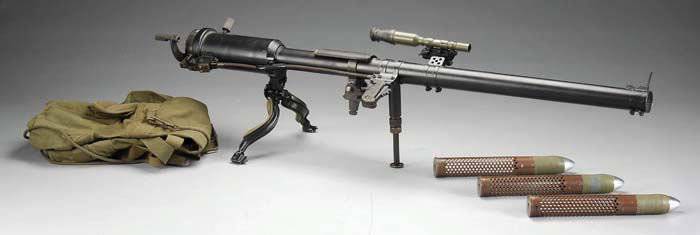
Unlike the Bazooka smooth-bore grenade launchers, which used jet grenades with feather or ring stabilizers, the M18 recoilless gun had a rifled barrel and a projectile with a perforated steel sleeve. In the rear of the steel rifled barrel with a length of 1560 mm there is a hinged gate with a nozzle for the release of powder gases, balancing recoil when fired. There was a bipod in front of the charging chamber, and opposite to the pistol grip with a trigger hook horizontally located on the right side was an additional support monopod, which, when fired from the shoulder, was used as an additional handle to hold weapons. On the left side of the barrel on the bracket was attached regular optical sight.
The mass of 57-mm missile-free projectile was 2,5 kg, of which about 450 g accounted for a powder propellant charge and 1,2 kg for a fired grenade. There were about 400 round holes in the steel sleeve through which part of the powder gases when fired into the nozzle, thereby compensating for the recoil of the weapon.
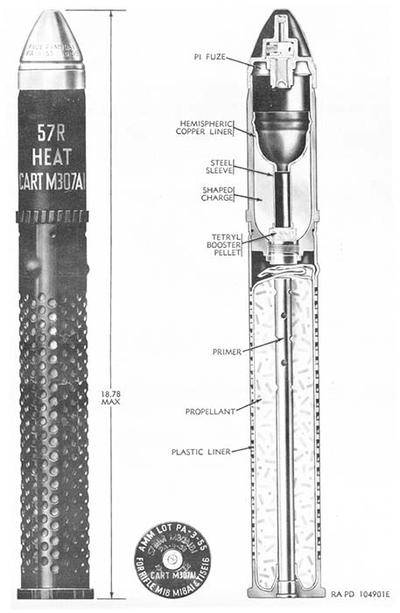
The propellant charge of pyroxylin powder inside the liner is in a burning bag of nitrocellulose fabric. The ignition charge was ignited by a pre-cocked drummer using a standard primer-igniter located at the bottom of the sleeve. The cumulative grenade had normal armor penetration - around 80-mm, which was not always enough to destroy medium tanks.
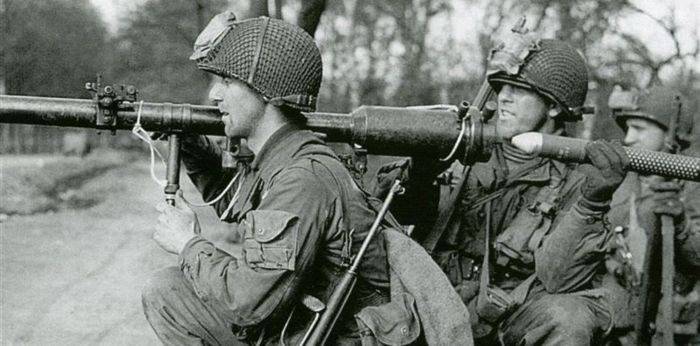
The shells are charged in a grenade launcher from the breech after the bolt is opened with the nozzle. After the shot, the cartridge case was manually removed from the barrel. Like any dynamo-reactive weapon, behind the 57-mm recoilless M18 there was a danger zone. The effective range of fire on armored vehicles was 350 m, the maximum range exceeded 4000 m. With a mass in the charged state of about 22 kg, it was possible to shoot from the shoulder, but the most accurate fire could be fought with the bipod into the ground or with a tripod machine from the M1917-X1 machine gun.
At the final stage of the Second World, the M18 recoilless gun was used rather limitedly. Much larger were the use of bezkotkok in armed conflict on the Korean Peninsula. After a collision with Soviet-made T-34-85 tanks, it turned out that the 57-mm cumulative grenade pierces the hull armor in about half of the cases, but the cumulative jet's action is weak. And even in the case of penetration of armor, the tank often did not lose combat capability. The frontal armor of the thirty-five tower was invulnerable to the fire of a 57-mm recoilless gun. Also 57-mm rocket grenades were practically useless against the ACS SU-100 and ISU-152 and the heavy tanks EC-2, which also took part in the Korean War in small numbers. The worst relative to 60-mm rocket-propelled grenades M6AZ / S (up to 120 mm), armor penetration is explained by the rotation of the 57-mm projectile, which in turn leads to “splashing” of the cumulative jet. At the same time, the range of effective fire and the presence of fragmentation, incendiary, and smoke projectiles in the nomenclature of ammunition made the M18 cannon quite effective against firing points and manpower much more than the Bazuki. Relatively light traction can be carried and used by one soldier. Along with 60-mm М9, М18 and 88,9-М20 rocket launchers, recoilless 57-mm guns were the main anti-tank agent in the American army and marines before the end of the 50-s.
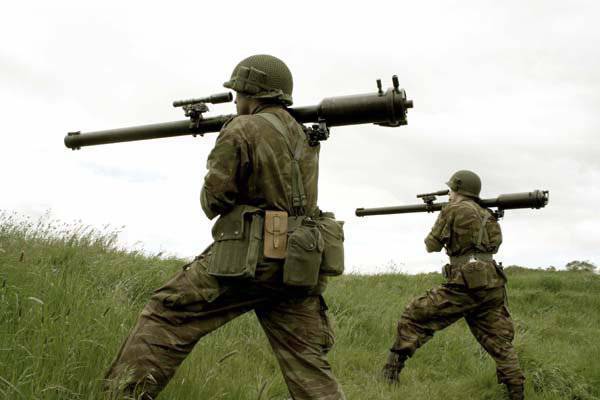
At the beginning of the 60, the M18 recoilless guns were withdrawn from combatant units due to their inability to effectively deal with modern tanks. After that, the mailboxes were kept in warehouses for some time. In 1968, the decision was made to remove 57-mm guns from service, and they were handed over to US-friendly regimes as part of military assistance. Light 57-mm guns M18 many fought in various conflicts of "low intensity", used mainly as a fire support weapon. The license for the production of the M18 was transferred to Brazil, where this weapon was adopted as an assault gun by paratroopers and marines. After a number of recoilless guns became trophies of the Chinese army in Korea, in the second half of the 50's, the production of the Chinese clone, designated the “Type 36”, began. The recoilless Chinese-made weapon was actively used in Indochina against the French, American and South Vietnamese troops, and was also used by the rebels in Afghanistan. In the 21 century, 57-mm wheelbarrows, developed over 70 years ago, are still in service with a number of developing countries in Africa, Asia, Central and South America.
Due to the inability of the 57-mm M18 guns to fight medium and heavy tanks, in June 1945, the 75-mm recoilless gun M20 was adopted. Structurally, this bezotkatka was in many respects similar to the 57-mm gun M18, but due to the increase in the caliber, its weight was 52 kg. The main weapon in the ammunition was considered to be a cumulative shot with a mass of 9,5 kg with armor penetration along the normal 90 mm. The cumulative grenade contained 400 of pentolite and left the barrel with a length of 2008 mm with an initial velocity of 300 m / s.
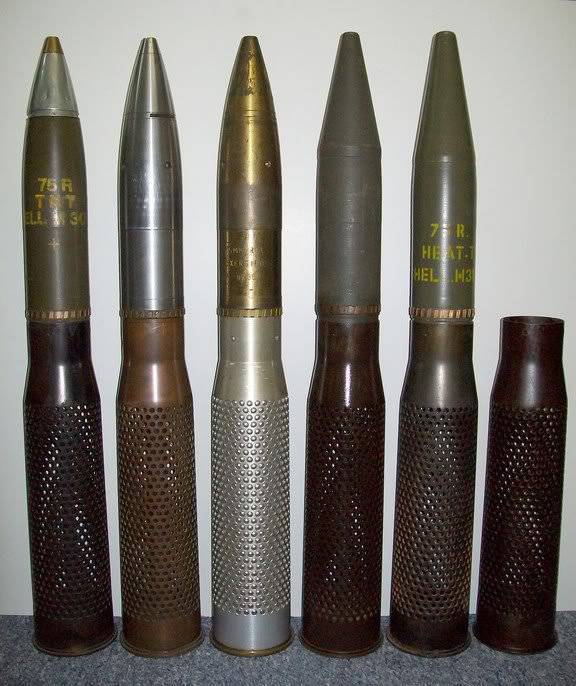
Also from the 75-mm guns M20 could fire fragmentation and incendiary grenades and even canister. The leading belts of the 75-mm projectiles had ready-made cuts, which, when loaded, were combined with the cuts of the gun barrel. The effective range of fire on the tanks did not exceed 600 m, the maximum range of high-explosive fragmentation projectile - 6500 m. Combat rate - to 6 shots / min.
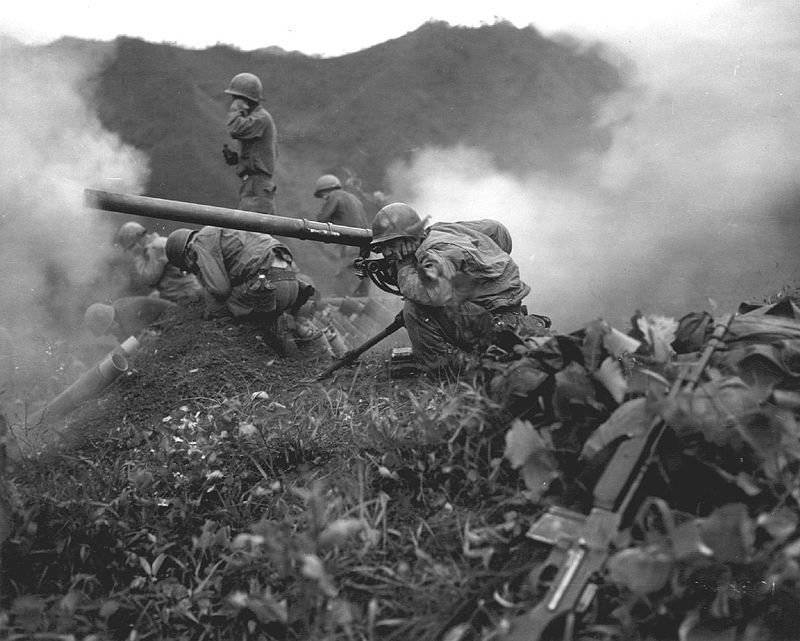
The recoilless guns M20 before the surrender of Japan managed to take part in the hostilities in Okinawa. But the most massively used during the Korean War. After the front line stabilized, and the fighting took a positional character, in many American units 57 and 75-mm recoilless guns very strongly pressed the 60 and 88,9-mm grenade launchers. This was due to the fact that, despite the significantly greater weight, the stumpboxes were much more long-range and could conduct effective fire with fragmentation shells when repelling attacks by Chinese and Korean infantry. In addition, unlike the lighter and more compact "Bazook" with electrozapalnaya scheme, in the recoilless guns used projectiles with ignition of powder charge by the mechanical action of the primer-igniter. In the humid climate of the Korean Peninsula, the usual mechanical triggering mechanism operated much more reliably.
For accurate guidance, the swiveling and lifting mechanisms of the implement are equipped with manual drives. Unlike 57-mm guns, the M20 was fired mainly from the machine. In the infantry units of the American Army, the 75-mm recoilless weapon was a regular anti-tank weapon of the battalion unit.
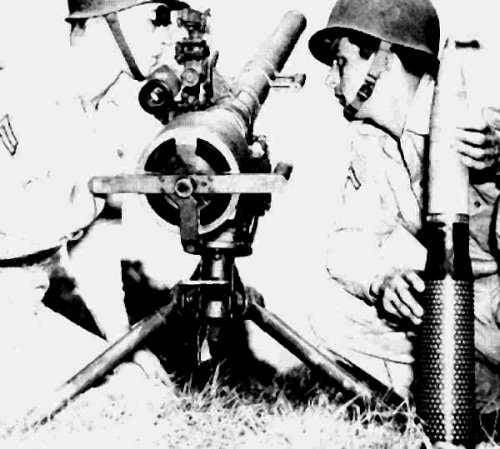
Although the characteristics of the armor penetration of the 75-mm cumulative projectile made it possible to confidently pierce the frontal armor of the T-34-85 hull, guns were rarely used against the tanks. Most often, M20, located on natural elevations, was used to fire at enemy positions and suppress firing points. Since the weapon could be carried by two combat numbers, it was common practice when the “wandering” boxless one made the 2-3 from one shot place, after which the calculation quickly transferred it to a new firing position.
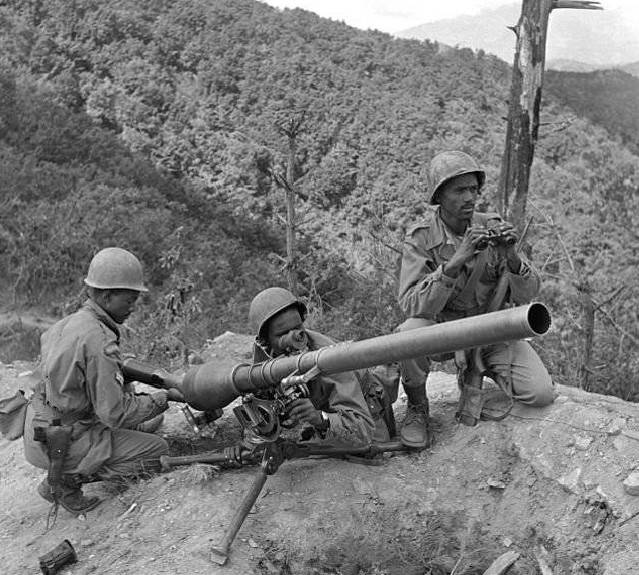
A significant amount of 75-mm recoilless guns M20 was captured by Chinese and Korean parts and was used against the former owners. The Chinese liked the cannon, and soon its unlicensed production began in China. The Chinese typeless 52 Type and 56 Type prior to the start of the 80-x were in service with the PLA and were actively exported. Chinese 75-mm recoilless guns fought in Indochina and were supplied to the Afghan Mujahideen. Several captured American 57 and 75-mm guns with ammunition were sent to the USSR, where they were tested at the sites.
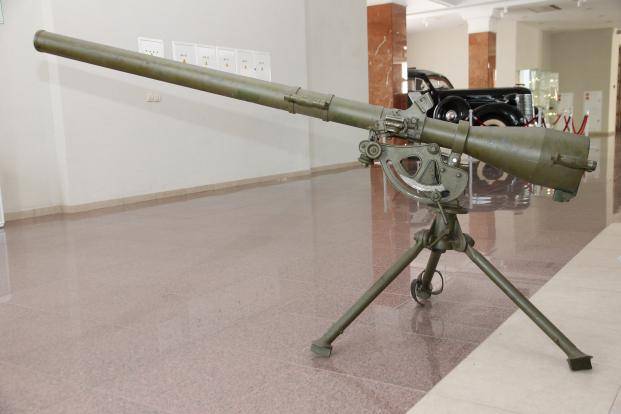
Soviet specialists positively evaluated the simple and robust design of American recoilless guns and relatively low weight, but noted the lack of armor penetration, which was associated with the stabilization of the cumulative projectiles by rotation. Back in the years of the Second World War in the Soviet Union, they realized that it was quite difficult to create an effective cumulative projectile for a rifled gun. In addition, the rifled barrel without rifle weighed more and was significantly more expensive than that of a smooth-bore gun, the shells of which were stabilized by feather stabilizers. In addition, the high visibility during firing and the need for careful selection of the firing position were attributed to the shortcomings of the American boxless riders, since a fairly long danger zone was formed behind the guns when fired. However, these features are peculiar to all, not just the American recoilless guns.
The recoilless 75-mm guns were in service with the United States before the start of massive deliveries of TOW guided anti-tank missiles. However, already at the beginning of 60-x, due to the inability to penetrate the frontal armor of post-war Soviet tanks, the M20 began to be withdrawn from combat units and sent to warehouses. The longest recoilless guns lingered in the assault units of the Marine Corps, where they were considered as portable assault artillery, capable of supporting fire in attack and defense. After the US military finally abandoned the 75-mm no-roll, several thousand guns were handed over to the allies. In some countries, the M20s are still in service, in the 21 century, 75-mm recoilless guns, for example, used Italian alpine arrows.
Although bezotkatki have a number of fatal disadvantages, their main advantages are relatively low weight and cost. In this regard, in the 50-s in the United States continued the development of artillery systems of this type. The increased security of Soviet tanks demanded an increase in the caliber of cumulative ammunition. In 1954, the production of the M106 40 mm recoilless gun began. Like the earlier models, the barrel of the 106-mm gun was rifled, and shells with perforated shells were used for firing. During the combustion of the propellant charge placed in a bag of nitrocellulose fiber, some of the gases went out into the holes and were thrown back through special nozzles in the breech breech, thus creating a reactive moment damping the recoil force.
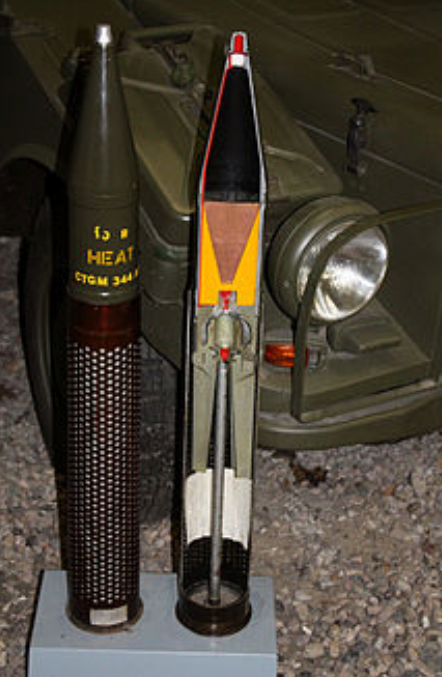
The ammunition consisted of shells for various purposes: cumulative, armor-piercing-high-explosive with plastic explosives, high-explosive fragmentation, fragmentation with ready-made lethal elements and incendiary. We should also dwell on the already forgotten armor-piercing high-explosive shells with plastic explosives. The creation of such ammunition was due to the desire of the military to have in the ammunition a single universal projectile, suitable for a wide range of tasks, depending on the installation of the fuse. When meeting with armor, the weakened head part of the projectile equipped with soft explosives flattens out, increasing the contact area, after which a blast occurs. Armor waves of tension appear, leading to detachment from its inner surface of the fragments flying at high speed, affecting the crew and equipment. However, after the appearance of unified battle tanks with multi-layer combined armor, the effectiveness of armor-piercing high-explosive shells dropped sharply and they were driven out by cumulative shells.
The 106-mm projectile with a cumulative warhead could penetrate 350 mm armor along the normal, which was quite enough to defeat Soviet tanks of the first post-war generation. The effective firing range of a cumulative projectile was 900 m, the maximum when firing a high-explosive fragmentation grenade with a mass of 18,25 kg - 6800 m. Fighting rate - 5 rds / min. For firing from closed positions on the gun had a corresponding sight. In the middle of the 60-x to expand opportunities in the conduct of hostilities in the dark of the day, some of the guns were equipped with an illumination night-sight with a range of up to 600 m.
An 12,7-mm semi-automatic rifle was fastened to the gun barrel parallel to the gun barrel. Shortened cartridges were used with special bullets corresponding to the 106-mm cumulative projectile ballistics. In the course of aiming, the gunner could navigate the trajectory of the flight of tracer bullets. In addition, when a bullet hit a tank, a cloud of white smoke was formed, noticeable in conditions of good visibility at a distance of up to 1000 m.
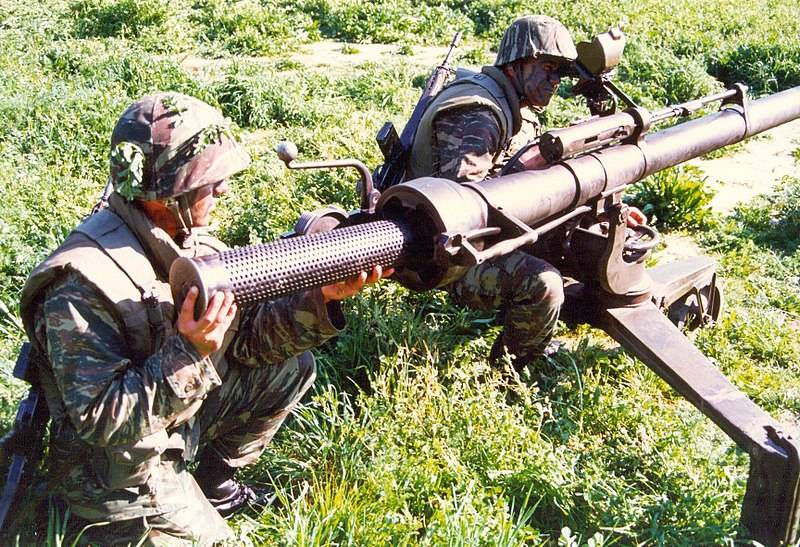
The gun was served by a calculation of four people, but if necessary, one fighter could fire from it. At the same time, the combat rate of fire did not exceed 2 rds / min. Pay for the growth of armor penetration and effective fire range was an increase in mass and dimensions. With the length of the 3404 mm gun, its weight in the combat position was 209 kg. Although the gun was disassembled into two main parts, it was no longer a question of carrying over considerable distances by the forces of calculation. A gun on a carriage with two sliding supports and a wheel was to be transported in the back of a truck. Due to the difficulties encountered in the delivery to the firing position, the main part of the M40 no-pay in the American army was installed on various vehicles. Most often, these were light all-terrain vehicles, and therefore 106-mm recoilless weapons can be considered an anti-infantry weapon with a stretch. However, due to the sheer power of the shells, the M40 guns were popular among the troops, used in many armed conflicts, and were officially in service in about 50 countries.
During the fighting, recoilless guns rarely fired on armored vehicles. Standard combat missions were - the destruction of enemy personnel, the destruction of light field fortifications and fire support for the advancing infantry. To do this, simple and reliable in use, possessing a sufficiently powerful projectile guns fit perfectly well.
In the US Army, due to the massive introduction of anti-tank guided missiles, 106-mm recoilless pieces were removed from parts of the first line in the middle of 70's. However, they have long been listed in the reserve and stored in warehouses. Due to the good operational and operational and combat characteristics of these, the most widely used, weapons in the armies of many other states continue to be used until now. In a number of countries, licensed production of 106-mm recoilless and ammunition for them was established.
During the Korean War, the American infantry units participating in the hostilities were quite well saturated with anti-tank weapons. But in a number of cases there was a paradoxical situation when, when a North Korean tank broke through, there was nothing to stop them. Often, in individual small units operating in isolation from the main forces, there were no rocket-propelled anti-tank grenade launchers or recoilless guns. The soldiers did not want to burden themselves with weapons, which in most cases turned out to be unclaimed. In the dominance of the American battlefield aviation, the complex terrain and positional nature of the fighting, North Korean and Chinese tanks rarely reached the front edge of the UN Forces. However, when this nevertheless happened, each time it was perceived as an emergency, and the American and South Korean infantrymen could not always stop the tanks breaking through. Very often, anti-tank weapons put in the state at the right time were in some kind of dugout, and not in the hands of the fighters. Unlike the armies of the “eastern bloc”, the US armed forces did not have hand-held anti-tank grenades that could be used individually by soldiers and were anti-tank weapons of the “last chance”.
In this regard, in 1953, the rifle 75-mm anti-tank grenade HEAT-RFL-75N “Energa” developed in Belgium was quickly adopted, fired by the blank cartridge with the 22-mm muzzle nozzle. After some refinement, a modification made in the USA was designated as M28.

According to the method of application, the M28 did not differ from the 51-mm M9 grenades used during World War II. Modified for the American army, M28 grenade with 655 g mass contained about 180 g Composition B explosives (a mixture of hexogen and TNT in the ratio 64 / 36) and was equipped with a sensitive piezoelectric fuse that triggered at an angle of meeting with armor over 20 °. During transportation, the piezoelectric fuse was covered with a removable plastic cap. The arming of the fuse took place at a distance of 8-12 meters from the shooter. Each M28 rifle grenade in a special case was attached with a blank 7,62-mm cartridge and a folding plastic frame sight with marks for shooting 25, 50, 75 and 100 m. The effective range of shooting at the tanks did not exceed 75 m. The armor penetration is overdraft. but in practice the grenade could not always penetrate the X-NUMX mm frontal armor T-200-45. Because of the strong recoil, shooting with an emphasis on the shoulder caused great discomfort, and when the butt rest focused on the ground, accuracy suffered.
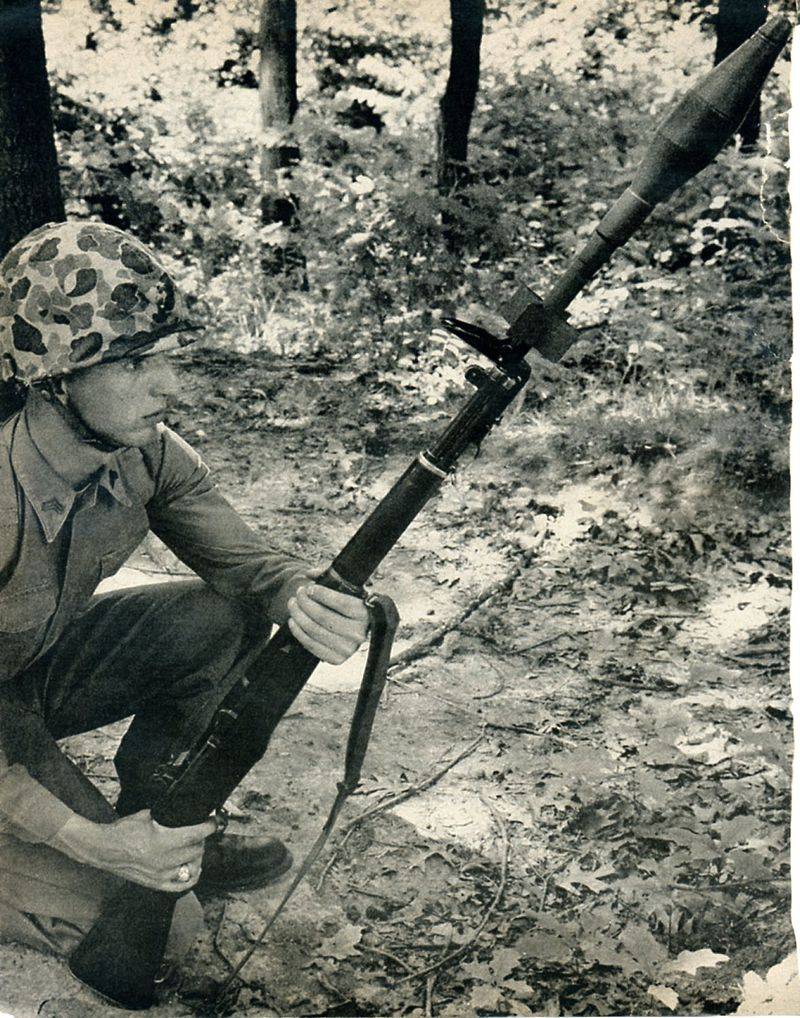
Marine prepares for a shot from a M1 Garand rifle with an M31 anti-tank grenade
In 1957, the 66-mm МNNXX 31 rifle-type cumulative grenade was adopted. It was originally intended to be launched by a blank cartridge from the flame arrester of the M1 Garand rifle, but was later adapted for use with the M14 rifle.
The armored penetration grenade M31 was similar to 75-mm M28, weighed 700 g and at the initial speed 53 m / s could fly off to 180 m. The effective firing range also did not exceed 75 m.
Even with the relatively low weight and ease of use rifle grenades were not popular among the soldiers. That was explained by the short distance of the effective shot, low armor penetration, the need to make extra manipulations with the weapon before the shot and load the rifle with the idle chuck. The M31 rifle grenades were used very limitedly during the Vietnam War, and after the appearance of the disposable M72 LAW grenade launchers, they were finally forced out at the end of the 60s. However, the ability to equip each shooter with light anti-tank weapons integrated with a standard rifle looked quite tempting, and they regularly returned to this idea.
In 1988, the US Army announced requirements for an “anti-rifle projectile” - RAAM (Rifle Launched Anti-Armor Munition). As part of this program, Olin introduced a cumulative grenade with a pulling jet engine placed in front of the 4's blade-type stabilizer. According to the data provided by the development company, the cumulative warhead of a grenade at a meeting angle of 90 ° ensured the penetration of 400 mm of homogeneous armor.
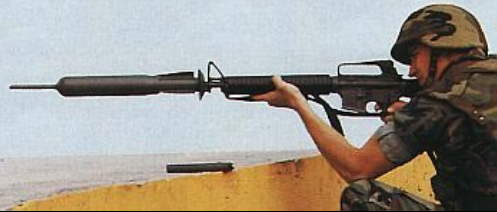
A grenade is launched from a special plastic nozzle attached to the muzzle of the barrel of the M16 rifle. The nozzle has two external screw grooves; when a grenade descends from the nozzle, it gets a rotation, stabilizing its flight. By installing a stabilizer in the bullet catcher tube, a 5,56-mm live cartridge can be fired. Due to the fact that the energy of the shot is enough to launch a jet engine at a safe distance for the shooter, it is possible to use a grenade from close indoor spaces, in addition, the unmasking signs of the shot are reduced. A grenade weighing 1650 g was shot at an initial speed of 35 m / s, after switching on the jet engine, it accelerated to 110 m / s. Aim range of shooting - up to 250 m. Cocking the head-fuse fuse is made at a distance of 12 m from the muzzle.
In general, the RAAM cumulative grenade showed good results for its mass and dimensions. Theoretically, this weapon could be used by each shooter armed with an M16 rifle, and seriously increased the anti-tank potential of small infantry units in the defense. The modern main battle tank with a multi-layered booking of a RAAM grenade couldn’t hit in the forehead of course, but there were certain chances when firing at the side. In addition, rifle grenades could be successfully used against lightly armored infantry fighting vehicles and armored personnel carriers. But since the completion of the test grenades coincided with the end of the Cold War and numerous Soviet tanks were no longer dangerous, and the US and NATO armed forces had a large number of different anti-tank weapons, the RAAM program was closed.
The fighting in Korea demonstrated that the modernization potential of the main anti-tank vehicle of the American infantry, the bazooka rocket launcher, has been exhausted. Although the armor penetration of the 88,9-mm M20 grenade launchers in the 50-s allowed to deal with all the serial Soviet tanks, the electric system of ignition of a reactive charge still caused a lot of complaints. Even after an induction generator began to be used as a source of electric starting pulse instead of dry batteries, the weapon often failed after being hit by rain. Reliability could be improved by using a shock trigger. At the end of the 50-x, a 90-mm rocket launcher was tested in the Waterwlit Arsenal, and its adoption was in 1961. Weapons weighing 15,8 kg received the designation M67 recoilless rifle - Recoilless rifle M67. The fire from a grenade launcher can be conducted both from the shoulder and supported on the ground, for which there is a two-leg adjustable bipod and an emphasis-monopod. The weapon is equipped with an optical sight with a threefold increase. The optical sight has a ranging grid, adjustment of lateral corrections and lead times, as well as a scale for setting the firing range to 800 meters. An 1346 mm long weapon was attached to the sighting device M49A1, from which it was possible to fire tracer 7,62-mm rifle cartridges.
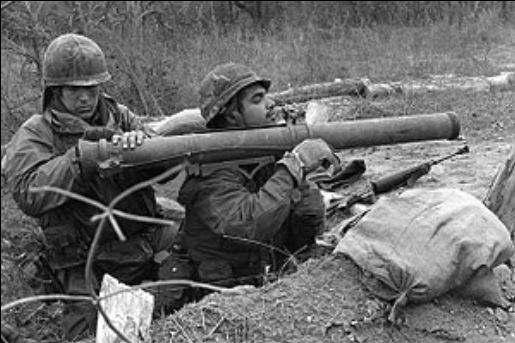
The use of a rifled barrel made it possible to bring the effective range of fire on moving targets to 420 m, but made the weapon heavy. In fact, the grenade launcher is the most lightweight recoilless gun with the bolt open to the right side. Grenade rounds weigh too little. Thus, the mass of the M371A1 cumulative projectile prepared for the shot, without capping, is 4,2 kg. Warhead weighing 3,06 kg contains 0,78 kg of explosive. Normally, a cumulative grenade is able to pierce a 350 mm homogeneous armor plate or 800 mm reinforced concrete. The initial velocity of the projectile M371A1 - 213 m / s.
In addition to the cumulative projectile, which was considered the main one, the ammunition consisted of shots with a K242 HE high-explosive fragmentation grenade with 3,2 kg mass and an initial speed of 205 m / s and an extreme range of 2090 m.
Based on the experience gained during the hostilities on the Korean Peninsula, the M590 artillery shells with ready-to-kill elements, such as feathered arrows, were introduced into the ammunition of the grenade launcher. When fired, a thin-walled aluminum container weighing 1,8 kg throws out 2400 arrows weighing 0,5 g, with a dispersion angle 8 °. The initial speed of the slaughter elements is 380 m / s, the firing range is up to 200 m.
The calculation of the M67 grenade launcher consists of three people: the gunner, the loader and the ammunition carrier. Until the middle of the 70-x 90-mm grenade launcher was the main anti-tank infantry units. Each infantry battalion in the state had 18 М67. In the second half of the 70-x, the TOW and M47 Dragon guided anti-tank missile systems reduced the number of 90-mm rocket launchers in the troops, but they were not completely ousted. Compared to the expensive anti-tank systems, which had a number of restrictions on the conditions of use, not containing sophisticated electronics, and a much more reliable grenade launcher was much simpler and cheaper to use. In addition, a trained crew could make 10 sighting shots from a rocket launcher in a minute, which is difficult to overestimate when repelling an enemy attack. The cost of rocket-propelled grenades is ten times less than the ATGM, besides the presence in the ammunition of various types of ammunition significantly expanded the scope of the grenade launcher. In addition to the United States, the licensed production of M67 grenade launchers was launched in South Korea. Since the beginning of the 70-s, M67 grenade launchers have been supplied in considerable numbers to American allies, including for the armed forces of South Vietnam, Taiwan, Greece, and countries of Latin America.
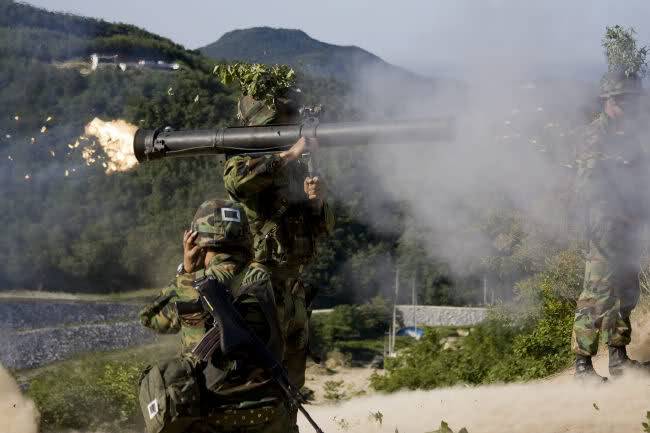
The M67 proved to be a very reliable and effective weapon, however, as in the case of the 57, 75 and 106-mm recoilless guns, it was used very rarely against enemy armored vehicles. 90-mm grenade launchers were widely used in Vietnam, the main targets for calculating М67 were enemy shelters and firing points. In the conditions of military clashes in the jungle, when visibility conditions were often less than 100 m, shots with arrow-shaped lethal elements, literally mowing down the attacking battle formations of the Vietcong, along with vegetation, showed very good results. However, there were cases when cumulative grenades destroyed the North Vietnamese tanks T-34-85 and T-54. During the invasion of Grenada in 1983, 90-mm grenade launchers were burned with four BTR-60s. In 80-ies, the armed forces of El Salvador actively used M67 grenade launchers in fights with rebels.
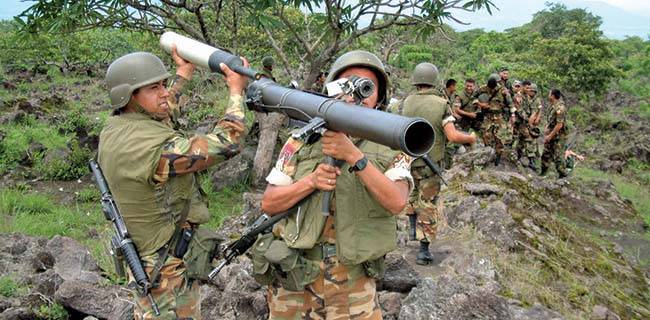
Rocket launchers of the American 193 Infantry Brigade in December 1989, during Operation Just Cause, provided fire support to infantry units and suppressed firing points of supporters of Manuel Noriega. Despite a decent age, the 90 mm M67 grenade launchers are still a “reserve weapon” in the US military. Thus, in 2011, the cases of using the M67 in Afghanistan by units of the 101 airborne division were recorded.
Another anti-tank weapon that received a baptism in the jungle of Southeast Asia was the disposable 66 LAW grenade launcher (eng. Light Anti-Tank Weapon - light anti-tank weapon). In the US military, the M72 grenade launcher became an individual freelance anti-tank infantry vehicle. After the start of mass deliveries to the troops, a disposable grenade launcher finally superseded the anti-tank rifle grenades. During the creation of individual anti-tank weapons, the German concept of a one-time anti-tank grenade launcher Panzerfaust was used, which was tested during the Second World War. However, the Americans significantly developed it, for the first time using a sliding transport and launch container that reliably protected the grenade during storage and transportation. The M72 LAW grenade launcher, created in 72 by Hesse Eastern Co, was in many ways a revolutionary weapon and was a role model for creating disposable grenade launchers in other countries. In March 1959, the M1961 LAW was officially adopted by the American Army.
Thanks to the use of fiberglass and inexpensive aluminum alloys, the grenade launcher is lightweight and relatively cheap. In 1962, for one M72 LAW, the US military paid $ 55.
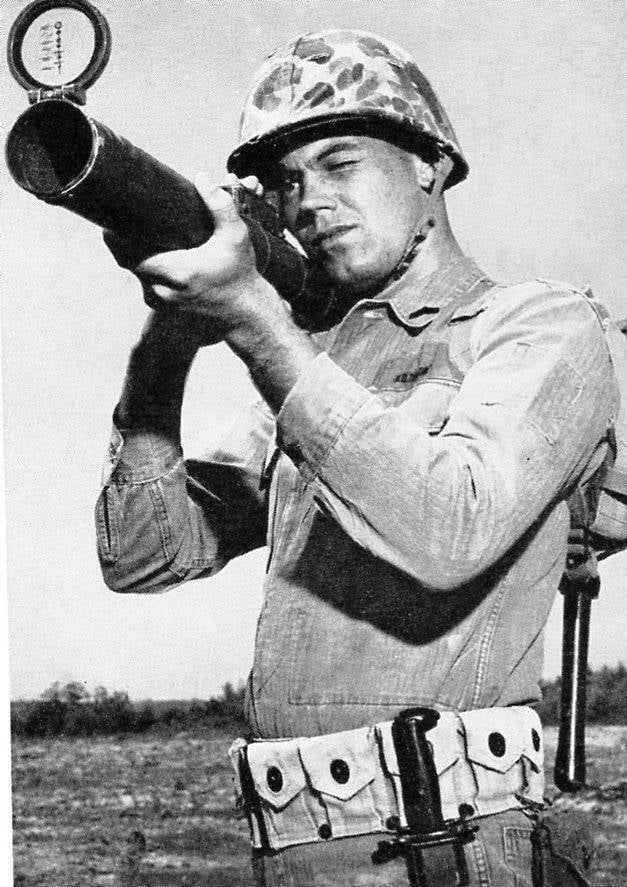
Infantryman with an early M72 model with a transparent front cover and a ranging scale applied on it
To launch a feathered cumulative grenade, a telescopic smooth barrel is used - internal aluminum and external fiberglass. On the body of the grenade launcher is located the launch device and an open mechanical sight. The trigger device, which also performs the role of a hermetic shipping container, is closed on both sides with hinged lids. During preparation for the shot, the covers are folded back, and the inner tube extends from the outer back, and the firing mechanism is opened and the folding sight opens. The shooter sets the launch tube on his shoulder, takes aim and pressing the start key produces a rocket grenade launch. The combustion of the charge of a solid fuel engine takes place entirely inside the launch tube. After departure from the launcher, the grenade is stabilized by folding tail. Cocking fuse occurs at a distance 10 m from the muzzle. As in the case of other rocket launchers, when fired from the M72 behind the shooter, a danger zone of a length of about 15 m is formed.
The mass of the grenade launcher is 3,5 kg, the length in the stowed position - 665 mm, in the battle - 899 mm. The initial grenade speed is 180 m / s. Declared armor penetration - 300 mm. Sights are designed for a range of up to 300 m. However, according to Lieutenant General Donald Keith, Deputy Chief of Staff of the United States Army for Research, repeatedly tested in practical terms, the effective range of shooting at mobile targets does not exceed 100 meters. Also, it can be considered overstated and indicators of armor penetration. In the course of actual hostilities, an M72 grenade launcher repeatedly sustained frontal armor of the hull and turret of the Soviet T-55 and T-62 tanks, but the defeat of the T-72 tanks was not at all. However, disposable 66-mm grenade launchers have become very common. The licensed production of the M72 LAW was conducted in Norway, Finland and Turkey. In the 80, the specialists of the Norwegian-Finnish company Nordic Ammunition Company developed a simpler, cheaper and more technologically advanced version of the M72-750 with a new engine. Subsequently, these improvements are used in the manufacture of the American sample. Nammo Talley supplied more than 350 000 grenade launchers to the US armed forces; in the 70-80s, production was also conducted at Hesse-Eastern and Norris-Thermador. Thus, more than half a million disposable 66-mm grenade launchers have been released in the US alone.
Due to the fact that the M72 LAW is frankly weak against modern tanks, several modifications were created in the 80-90 years, designed to destroy lightly armored targets, with enhanced armor and fragmentation effect. Officially, the M72 LAW grenade launchers are in service in two dozen countries and have been actively used in many armed conflicts. During the Vietnam War, 66-mm disposable grenade launchers were used mainly against manpower and firing points.
The cumulative warhead badly hit the infantry, hiding in various structures and behind light obstacles. After the DRV army began using T-34-85, T-54 and PT-76 tanks in offensive operations, grenade launchers were used for their intended purpose. While the T-54 armor was most likely amazed in the majority of cases, the T-50 hull armor made its way into approximately 76% hits. Oddly enough, the floating light-armored PT-72 demonstrated good survivability. The displacement hull, creating an effect close to the spaced armor, kept the hits of cumulative grenades well. Several thousand М72 LAW became the trophies of the North Vietnamese troops. Trophy grenade launchers were actively used in the offensive operations of the Vietcong at the final stage of hostilities. After the Soviet specialists got acquainted with the American M1972 grenade launcher, in the USSR in the 18, the disposable RPG-XNUMX “Mukha” was adopted.
Like many other American weapons, disposable grenade launchers spread throughout the world and often ended up in the hands of various rebel and terrorist organizations. The next major conflict involving one-off grenade launchers was the Civil War in Lebanon. М72 actively applied all parties to the conflict. Quite predictably, the 60-mm rocket-propelled grenades were powerless against Israeli tanks equipped with dynamic armor, but they easily penetrated the aluminum armor of the M113 BTR. In September, Palestinian gunmen LAW destroyed an Israeli Bell 1985 helicopter with 212 of the year.
October 7 1986 of the year with the help of M72 grenade launchers attempted to attack the Chilean dictator Augusto Pinochet. But the soldiers of the United Front to them. M. Rodriguez wrong choice of shooting range. The grenade, launched from too close a distance, did not have time to get on the combat platoon and, breaking through the armor-glass, got stuck in it without exploding.
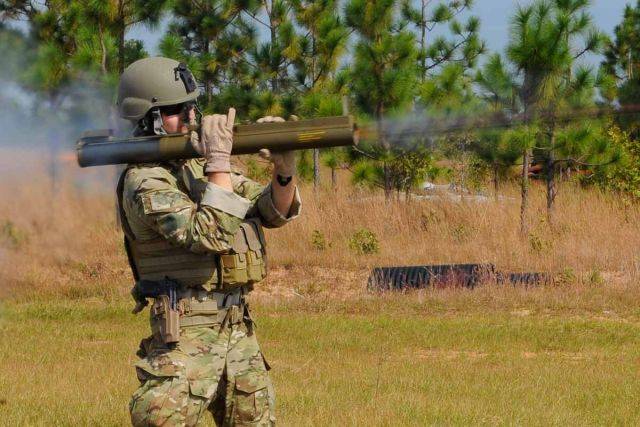
The US Army and Marine units used the M72А6, М72А7, and M72E10 modifications as assault weapons in all conflicts involving US ground forces. Shooting at armored vehicles was extremely rare, grenade launchers were mainly used as assault weapons of fire support. Currently, the M72 LAW is no longer considered an anti-tank weapon in the US military and has been replaced by AT4 grenade launchers manufactured in the United States under license from the Swedish company Saab Bofors Dynamics. For special operations forces, Nammo Talley supplies the M72 “Improved LAW” grenade launchers. Improved rocket launchers are available in various versions, differing in a more powerful jet engine, providing greater initial speed and firing range, as well as with more powerful cumulative fragmentation warheads. American special forces prefer 66-mm grenade launchers because of their compactness and lower weight compared to 84-mm AT4.
Perhaps the most unusual rocket launcher, adopted in service in the United States after World War II, was the M202 FLASH (English Flame Assault Shoulder Weapon - a flamethrower weapon used from the shoulder). Initially, the 66-mm four-barrel M202 was designed as a jet flamethrower and was designed to replace jetpack flamethrowers. Prototypes, tested in Vietnam under the designation XM202, have proven to be positive. 453 g fire grenades fueled by self-igniting triethylaluminum reliably hit targets in dense tropical undergrowths. In the serial modification, the volume of incendiary fluid was brought to 600. The capsule with fire mixture was splitting from the impact at the moment of its fall, splashing burning viscous fluid in the radius to 10 m. The initial speed of the incendiary projectile is 115 m / s. Sure defeat of fixed point targets with flamethrower shots is possible at a distance of up to 250 m, areal - up to 500 m. Maximum firing range is 750 m.
In total, the US army units that fought in Southeast Asia, beginning with 1969, received 1095 XM202 and 16740 equipped XM74 firearms for them (66960 shots) for full-scale combat tests. After the completion of military tests, the four-barreled launcher was put into service under the designation МХNUMX.
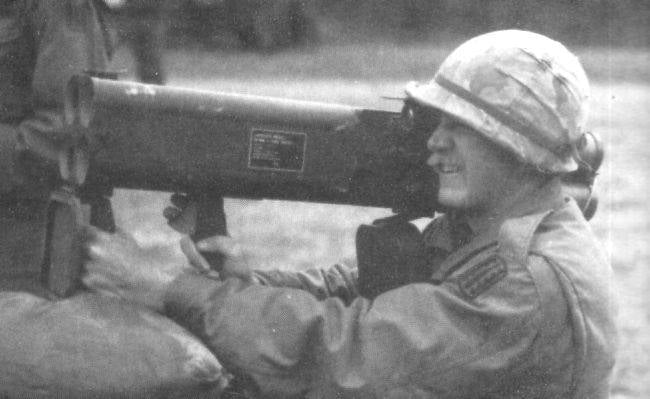
The M202 flamethrower is a reusable starting device with a block of four smooth barrels of 66-mm caliber. In the stowed position, the trunks are closed with front and rear flaps. In preparation for firing, a container consisting of four aluminum tubes, each of which contains one fired missile, joins the launch device. After the shooting of all four missiles, the container is disconnected from the launcher and ejected. To control the fire there is a folding pistol grip with a trigger, located under the body, as well as a collimator sight on the folding bracket on the left side of the flamethrower body.
To expand the scope of the ammunition, they introduced an 66-mm grenade with a cumulative warhead. Weapons with an expanded assortment of ammunition received the designation Multishot rocket launcher M202A1 (Rus. Multipurpose rocket launcher M202A1). Due to the use of a block of four barrels, the launcher was quite weighty. With a length in the combat position 833 mm, the weight was 12,7 kg.
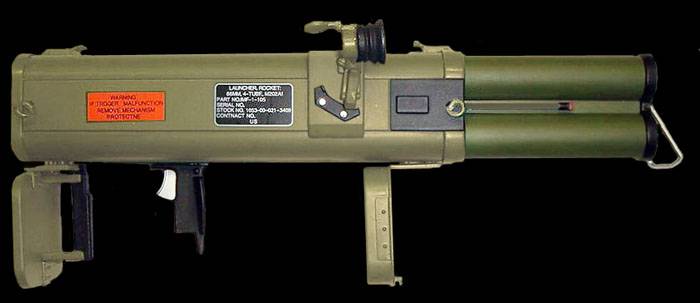
The effective firing range of cumulative grenades is up to 200 m. According to American data, at the 125 distance m half of the shots fit into a square the size of 2х2 m. , there is a possibility of fighting only tanks of the first post-war generation. On which there are no additional anti-cumulative screens or dynamic armor.
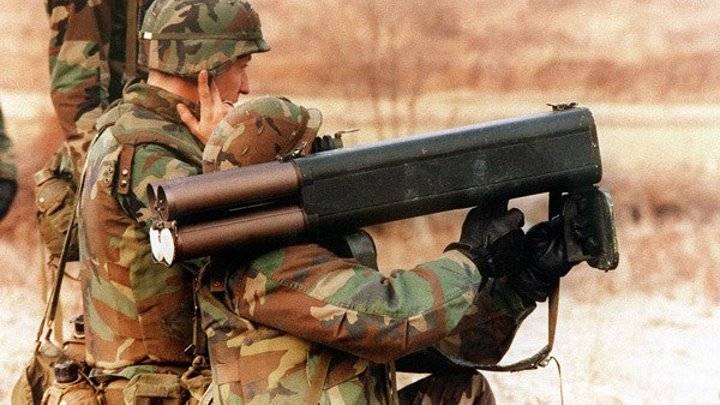
In the 90s, the four-barreled M201-1 universal grenade launchers were put into reserve. This is primarily due to a number of accidents during training shooting. Shots filled with fire mixture, due to long-term storage at the moment of loading the container into the launching device, were destroyed, while the flammable liquid spontaneously ignited. As a result, flamethrowing shots of the early series were disposed of, and launchers were placed in warehouses. But, apparently, a number of M201A1 in the troops is still there. In the recent past, the use of four-barreled grenade launchers was noted during the antiterrorist campaign in Afghanistan. It turned out that incendiary shells smoked the Taliban from various shelters and caves quite well.
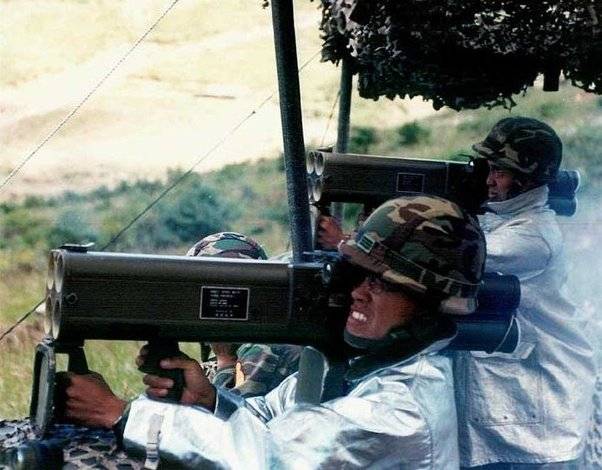
Another country where they adopted the M201A1, was the Republic of Korea. But unlike the United States, the four-barrel 66-mm grenade launchers in the South Korean armed forces are still actively exploited.
In 1985, the M201А1 grenade launcher appeared in the film “Commando”, where Arnold Schwarzenegger starred in the title role of retired colonel John Matrix. Moreover, according to the script of the film, the grenade launcher was taken from a robbed gun shop. Of course, in the 80-ies, the American weapons legislation was more liberal than it is now, but there were no rocket launchers capable of firing cumulative and incendiary projectiles even freely then.
To be continued ...
Based on:
http://www.combatreform.org/riflehandgrenades.htm
http://www.inetres.com/gp/military/infantry/antiarmor/M67.html
http://www.inert-ord.net/usa03a/usarg/rg/index.html
http://www.warboats.org/stonerordnotes/M40%20RCL%20R3.html
http://weaponland.ru/board/vintovochnaja_granata_m31/25-1-0-160
https://www.globalsecurity.org/military/library/policy/army/fm/23-11/index.html
http://www.combatreform.org/reconinforce.htm
http://www.military-history.org/
Hogg Ian. Crushing armor Anti-tank weapons on the battlefields of the twentieth century. - M .: Eksmo, 2006.
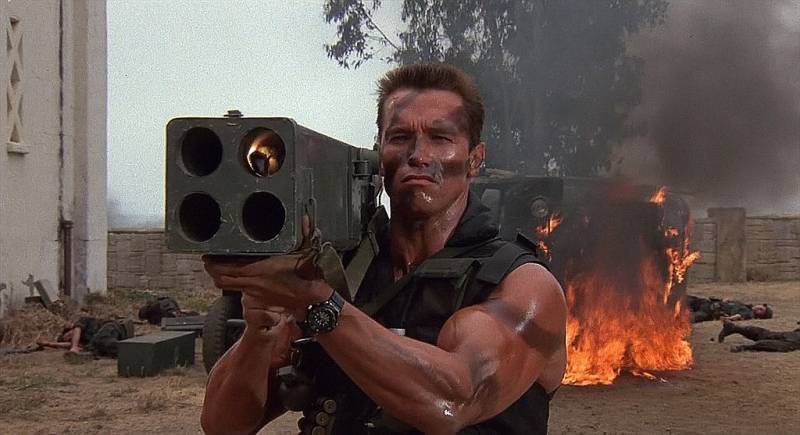
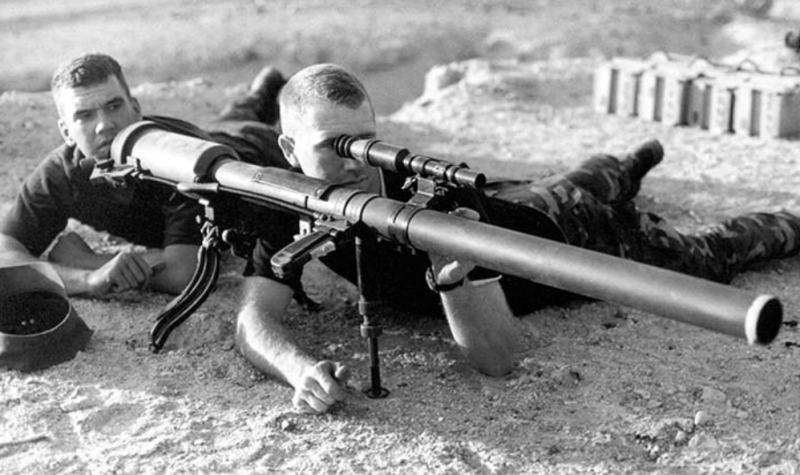
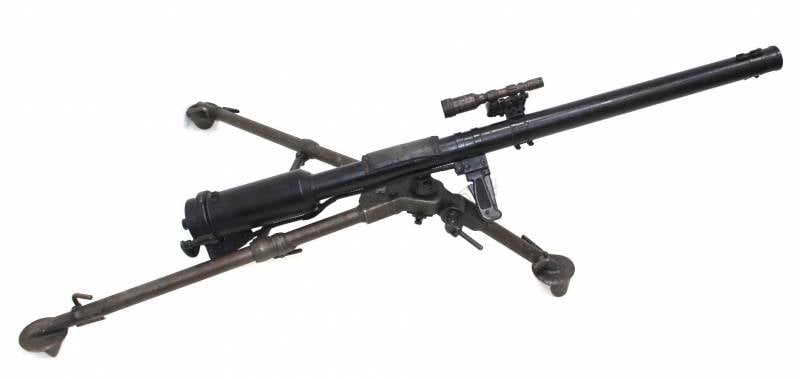
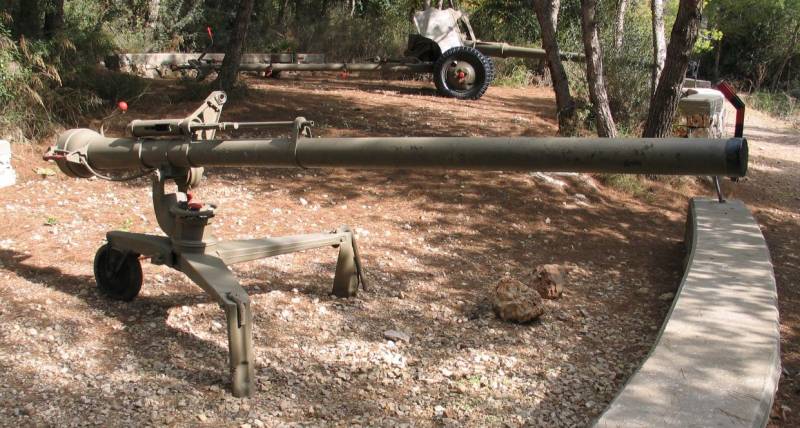

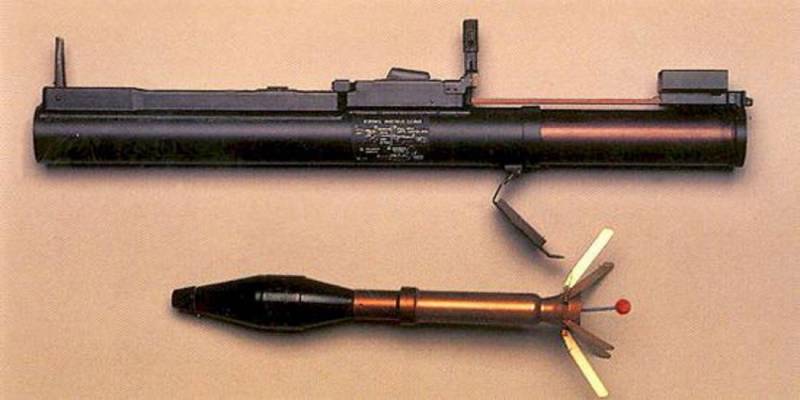
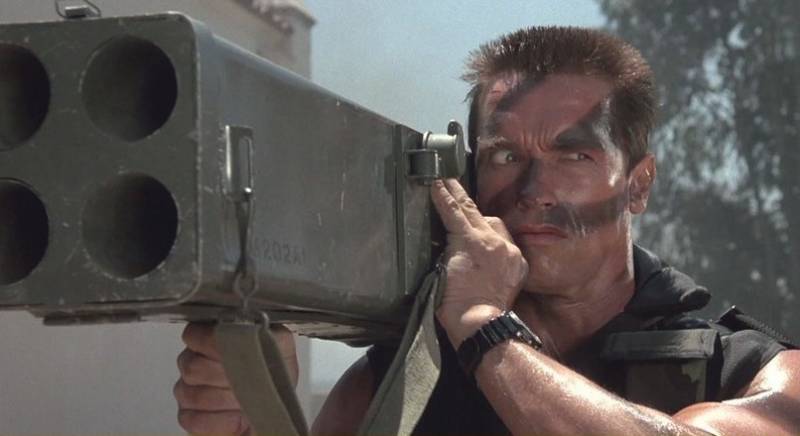
Information